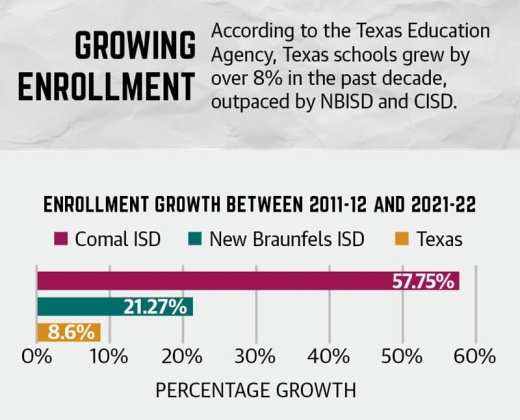In NBISD, enrollment took a slight dip in the 2020-21 school year due to the onset of the COVID-19 pandemic, somewhat in line with the statewide trend. However, CISD actually saw continued student body growth that year, though at a slower rate than recent year-over-year increases.
That trend is not isolated to the past year alone. In the past decade, Texas overall grew student enrollment by 8.6% from 2011-12 school year to the 2021-22 school year. In NBISD, enrollment grew by 21.27% in that same period and in CISD, that growth in the student population was 57.75%.
That growth is much in line with the growth of the city overall. From 2010-20, New Braunfels grew by 56.51%, from 57,740 residents to 90,370, according to U.S. census data.
“Under 18 [years old] was our highest growth bracket—that was more than five times the regional average,” said Jonathan Packer, president and CEO of the Greater New Braunfels Chamber of Commerce at a recent presentation to the New Braunfels City Council on findings in the chamber’s 2023-27 Economic Development Strategic Plan. “That’s roughly an elementary school per year. So you see the challenges school districts are facing. Adding an elementary school every year is a major source of that.”
Where is the growth?
Growth patterns vary within New Braunfels, and that is something that serves as a target for where the districts will prioritize new schools and facilities.
Recently in NBISD, the district scrapped a plan to combine Carl Schurz Elementary and Seele Elementary schools in one location and close the current campuses due in part to their age. The campuses were built in 1924 and 1950, respectively.
This action would have freed up funding from the 2018 bond to build a new elementary school where growth is occurring most rapidly, NBISD Superintendent Cade Smith said. However, changes in demographic projections on where that growth will take place in the city shifted since that 2018 bond passed.
Smith said moving that school to where more growth is forecast in the city, as well as a potential new elementary on the opposite side of town, will help where the district is seeing its most growth in terms of new subdivisions on the outskirts of the district—specifically along Klein Road and Zipp Road in the Guadalupe County side of the district and in the western area around the Veramendi subdivision.
“All of that growth and expansion at the elementary level eventually funnels up to our secondary schools. Both middle schools are projected to be over capacity by the 2026 school year, and both high schools near or over capacity within the decade,” Smith said.
In CISD—a district that encompasses all of the rest of Comal County outside the NBISD boundaries and dips slightly into neighboring counties—growth is occurring rapidly in the center of the county off Hwy. 281 and FM 1863 along with the northern part of New Braunfels in Comal County. Growth is also occurring in Guadalupe County that includes subdivisions off Hwy. 46 and near and around the Creekside shopping center, said Steve Stanford, assistant superintendent of communications and organizational alignment for CISD.
The New Braunfels parts of the district are seeing the biggest impact on growth.
“Elementary No. 19 has been built off [Hwy.] 46 in between Freiheit [Elementary] and Clear Spring Elementary,” Stanford said. “The big story really for us on the New Braunfels side of the district is the Mayfair development going up on I-35. That’s 6,000 homes. We’ve already got land for a couple elementary, middle school and a high school up there that we’re working on securing.”
Forecasting enrollment increases
Even with the possibility of an economic recession on the horizon, both districts are expecting to see continued growth. The demographic report from Zonda Education released last year forecasts the district will reach 13,000 students by the 2030-31 school year, or more than a 34% increase over current enrollment.
In CISD, growth projections forecast more than 40,000 students by the 2029-30 school year, or a more than 47% increase over current enrollment.
“So that we can stay on top of the growth, we are in the process of creating a Long Range Facilities Planning Committee,” Smith said. “This committee will be charged with developing a 10-year drafted plan of district facilities that can accommodate the fast growth we are seeing. They will look at updated demographer’s projections, finances and other data sources.”
Smith added that community surveys will be on the horizon to ask the public for feedback on buildings and other items.
“Historically, if you go back to the 2008 recession, when there was a housing decline, we still experienced growth in Comal ISD,” Stanford said. “What our demographer has told us is if there’s any slowdown in the housing market, it means that we’ll grow 2%-3% a year versus 5%-6% a year.”







